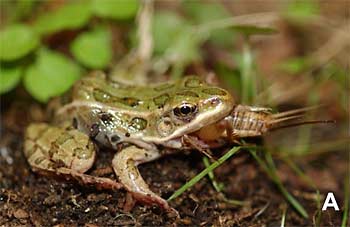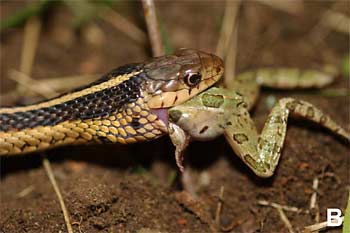UC Berkeley Press Release
 Flavobacterial meningitis prevents this leopard frog from lifting its head. The disease is caused by a normally benign bacteria that takes advantage of the impaired immune systems of pesticide-exposed frogs. (Photos by Tyrone Hayes/UC Berkeley) |
Pesticide combinations imperil frogs
BERKELEY – The pesticide brew in many ponds bordering Midwestern cornfields is not only affecting the sexual development of frogs, but is making them more prone to deadly bacterial meningitis, according to a new study by University of California, Berkeley, scientists.
These physiological effects combine with environmental disruptions to make the life of a frog seem like something out of a horror movie and are likely among the factors causing a decline in amphibian populations worldwide, the researchers said.
 Tadpoles raised in water polluted with a combination of nine pesticides, fungicides and herbicides typical of ponds around Midwestern cornfields take longer to become frogs and end up smaller, making it harder for them to eat their normal prey and making them easier prey for other animals. The top frog is having trouble eating a cricket, while the snake has no trouble swallowing the smaller frog.  |
"If you look at one of these frogs, it's probably a hermaphrodite - plus, it metamorphoses late, which means it is subject to its pool drying up before it can become a frog," said lead researcher Tyrone Hayes, professor of integrative biology at UC Berkeley. "It's also smaller, if it metamorphoses at all, which increases the likelihood it will be eaten and decreases its ability to eat. Plus, it's immuno-suppressed, so more prone to die from infection."
The stress on the frogs is increasing stress hormone levels, he found, which in turn create holes in the thymus gland that likely cause the impaired immune response.
"It's not the pesticides alone or introduced predators or ultraviolet light or global warming that's causing this decline, but the interaction between these on an animal that is pretty sensitive to its environment," said Hayes.
In the new paper, published online last week in the journal Environmental Health Perspectives, Hayes and his colleagues report four years of experiments showing that, while some of the pesticides, herbicides and fungicides used on corn fields may not by themselves have a noticeable impact on frogs, in combination they create significant effects. Among these are delayed maturation - the tadpoles take longer to metamorphose into frogs - retarded growth and an increased susceptibility to meningitis caused by normally benign bacteria.
Four years ago, Hayes showed that atrazine, the most common weed killer used on corn in the United States, disrupts the sexual development of frogs, feminizing males into hermaphrodites - frogs with female sex organs invading their testes - decreasing the size of their vocal organs, which are critical to mating success, and causing a tenfold drop in testosterone in mature male frogs.
In the current study, he looked again at atrazine as well as three other herbicides, two fungicides and three insecticides used on Midwestern cornfields - a subset of more than two dozen pesticides approved for use. All nine were found in the scientists' study area in Nebraska in pools of water beside cornfields early in the growing season, when spraying typically occurs. Levels ranged from 0.1 parts per billion (ppb) to 10 or more ppb.
Native northern leopard frogs (Rana pipiens) raised in water with only one of these nine pesticides at 0.1 ppb appeared normal, though the fungicide propiconazole caused a small but significant increase in the time it took tadpoles to start metamorphosis. The insecticide tebupirimphos caused a small but statistically significant decrease in the size and weight of mature frogs.
Mixtures, however, had a much stronger effect. All nine compounds together at 0.1 ppb - one of the lower concentrations measured in the field - lengthened the time to metamorphosis by 15 days, or about 25 to 30 percent. The mixture also caused a frog mortality of 35 percent.
All nine compounds together also produced a startling effect: The longer a tadpole took to mature into a frog, the smaller it was. It's normally the other way around, Hayes said. Separately, six of the pesticides did not affect this correlation, but three disrupted it so that there was no relationship between time to metamorphosis and size at metamorphosis.
"In humans, this is like saying, 'The longer you are pregnant, the smaller your baby will be,' which means the womb is no longer a nurturing environment," Hayes said.
The nine-pesticide combo also damaged the thymus, a part of the immune system, causing 70 percent of frogs to develop flavobacterial meningitis. The pesticides atrazine and S-metolachlor, which are marketed as the combination Bicep II Magnum, caused the most thymic damage.
To investigate why, Hayes and his laboratory colleagues, mostly undergraduate students, raised larvae of the common laboratory frog, the African clawed frog (Xenopus laevis), in water containing these pesticides and found four times the normal level of the stress hormone corticosterone. Hayes suspects that not all of the pesticides affect frogs, but that some enhance or trigger the deleterious effects of others when combined.
"Estimating the ecological risk and the impact of pesticides on amphibians using studies that examine single pesticides at high concentrations only may lead to gross underestimations of the role of pesticides in amphibian declines," he wrote.
In a second study also published online last week in Environmental Health Perspectives, Hayes reported even stronger evidence that atrazine, a powerful endocrine disruptor, both chemically castrates male frogs by blocking the action of the male steroid androgen and feminizes them by stimulating the production of the female hormone estrogen. He was able to produce identical hermaphroditic malformations in frogs by administering estrogen or blocking androgen at the proper time of development.
"One week of exposure at the critical time is all that's required to make these males look feminine, which probably interferes with mating," he said. Noting that some frogs seem to adapt to atrazine by delaying development, presumably so that the critical developmental period takes place when the herbicide is at its lowest, Hayes suspects that not all frogs would be expected to adapt, or to adapt quickly enough, to survive. Plus, delayed maturation comes at the risk of having the pond turn into a puddle and dry up before the frog completely metamorphoses.
Hayes is continuing his studies with various combinations of pesticides to determine which are the true cause of the problem and which serve to enhance the effect of others.
His laboratory colleagues were UC Berkeley students Paola Case, Sarah Chui, Duc Chung, Cathryn Haefele, Kelly Haston, Melissa Lee, Vien Pheng Mai, Youssra Marjuoa, John Parker and Mable Tsui. Co-authors on the atrazine paper were former UC Berkeley students A. Ali Stuart, Atif Collins, Nigel Noriega, Aaron Vonk, Gwynne Johnston and Dzifa Kpodzo, and current students Magdalena Mendoza and Roger Liu.
The work was supported by the National Science Foundation, Henry H. Wheeler, the Park Water Co. and the Howard Hughes Biology Scholar's Program.

